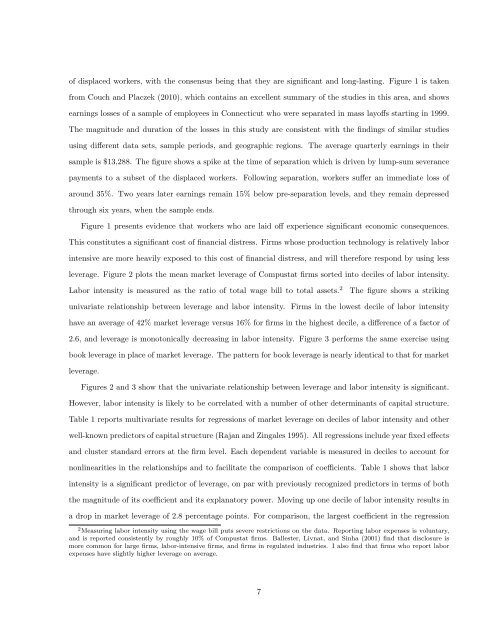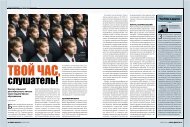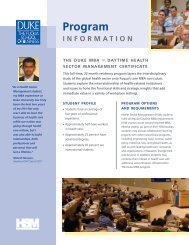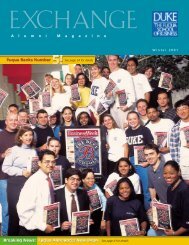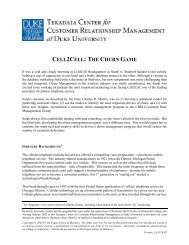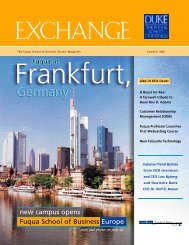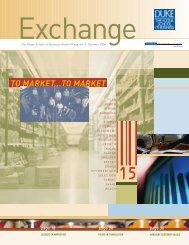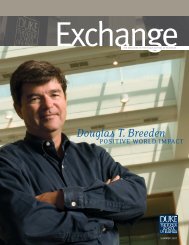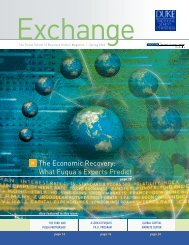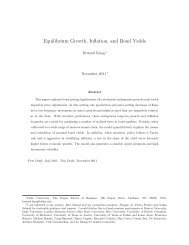A Structural Model of Human Capital and Leverage - Duke ...
A Structural Model of Human Capital and Leverage - Duke ...
A Structural Model of Human Capital and Leverage - Duke ...
Create successful ePaper yourself
Turn your PDF publications into a flip-book with our unique Google optimized e-Paper software.
<strong>of</strong> displaced workers, with the consensus being that they are significant <strong>and</strong> long-lasting. Figure 1 is taken<br />
from Couch <strong>and</strong> Placzek (2010), which contains an excellent summary <strong>of</strong> the studies in this area, <strong>and</strong> shows<br />
earnings losses <strong>of</strong> a sample <strong>of</strong> employees in Connecticut who were separated in mass lay<strong>of</strong>fs starting in 1999.<br />
The magnitude <strong>and</strong> duration <strong>of</strong> the losses in this study are consistent with the findings <strong>of</strong> similar studies<br />
using different data sets, sample periods, <strong>and</strong> geographic regions. The average quarterly earnings in their<br />
sample is $13,288. The figure shows a spike at the time <strong>of</strong> separation which is driven by lump-sum severance<br />
payments to a subset <strong>of</strong> the displaced workers. Following separation, workers suffer an immediate loss <strong>of</strong><br />
around 35%. Two years later earnings remain 15% below pre-separation levels, <strong>and</strong> they remain depressed<br />
through six years, when the sample ends.<br />
Figure 1 presents evidence that workers who are laid <strong>of</strong>f experience significant economic consequences.<br />
This constitutes a significant cost <strong>of</strong> financial distress. Firms whose production technology is relatively labor<br />
intensive are more heavily exposed to this cost <strong>of</strong> financial distress, <strong>and</strong> will therefore respond by using less<br />
leverage. Figure 2 plots the mean market leverage <strong>of</strong> Compustat firms sorted into deciles <strong>of</strong> labor intensity.<br />
Labor intensity is measured as the ratio <strong>of</strong> total wage bill to total assets. 2 The figure shows a striking<br />
univariate relationship between leverage <strong>and</strong> labor intensity. Firms in the lowest decile <strong>of</strong> labor intensity<br />
have an average <strong>of</strong> 42% market leverage versus 16% for firms in the highest decile, a difference <strong>of</strong> a factor <strong>of</strong><br />
2.6, <strong>and</strong> leverage is monotonically decreasing in labor intensity. Figure 3 performs the same exercise using<br />
book leverage in place <strong>of</strong> market leverage. The pattern for book leverage is nearly identical to that for market<br />
leverage.<br />
Figures 2 <strong>and</strong> 3 show that the univariate relationship between leverage <strong>and</strong> labor intensity is significant.<br />
However, labor intensity is likely to be correlated with a number <strong>of</strong> other determinants <strong>of</strong> capital structure.<br />
Table 1 reports multivariate results for regressions <strong>of</strong> market leverage on deciles <strong>of</strong> labor intensity <strong>and</strong> other<br />
well-known predictors <strong>of</strong> capital structure (Rajan <strong>and</strong> Zingales 1995). All regressions include year fixed effects<br />
<strong>and</strong> cluster st<strong>and</strong>ard errors at the firm level. Each dependent variable is measured in deciles to account for<br />
nonlinearities in the relationships <strong>and</strong> to facilitate the comparison <strong>of</strong> coefficients. Table 1 shows that labor<br />
intensity is a significant predictor <strong>of</strong> leverage, on par with previously recognized predictors in terms <strong>of</strong> both<br />
the magnitude <strong>of</strong> its coefficient <strong>and</strong> its explanatory power. Moving up one decile <strong>of</strong> labor intensity results in<br />
a drop in market leverage <strong>of</strong> 2.8 percentage points. For comparison, the largest coefficient in the regression<br />
2 Measuring labor intensity using the wage bill puts severe restrictions on the data. Reporting labor expenses is voluntary,<br />
<strong>and</strong> is reported consistently by roughly 10% <strong>of</strong> Compustat firms. Ballester, Livnat, <strong>and</strong> Sinha (2001) find that disclosure is<br />
more common for large firms, labor-intensive firms, <strong>and</strong> firms in regulated industries. I also find that firms who report labor<br />
expenses have slightly higher leverage on average.<br />
7


